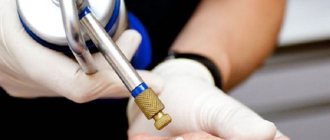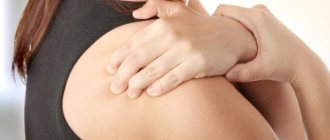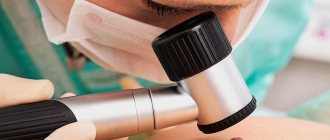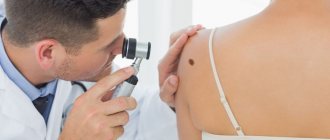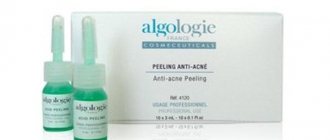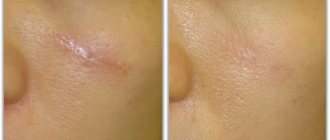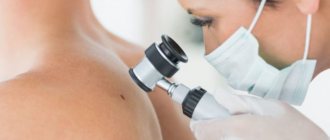Cryosurgery is the local application of low temperatures to destroy body tissue. This treatment method is used mainly for skin lesions, but also has wider applications in ophthalmology, gynecology, neurosurgery, cardiology and oncology. Pediatric cutaneous cryosurgery refers to the local application of subzero temperatures to achieve controlled destruction or removal of benign skin lesions. This method of cryosurgery is also called cryodestruction. In children, this method is used to treat molluscum contagiosum, plantar warts, and warts on the hands and fingers. Cryodestruction, unlike other surgical methods, is carried out without pain, effectively and quickly.
Cryodestruction of neoplasms
Cryodestruction is a minimally invasive technique for removing tumors using ultra-low temperatures.
It is painless, safe and has a quick recovery period. The essence of the cryodestruction method is to freeze tissues that have undergone pathological changes with liquid nitrogen. When exposed to cold, water in tissues turns into ice crystals, which damage cell membranes. Irreversible destruction (destruction) of cells occurs.
The procedure is used in cosmetology, gynecology, dermatology and aesthetic medicine to remove benign and malignant formations on the skin, mucous membranes and internal organs.
In cosmetology, cryodestruction is used to remove common and plantar (flat) warts, papillomas, moles, calluses with a core, keratosis, and condylomas.
Removal of neoplasms with nitrogen: features of the procedure
This procedure is known in the medical field as cryodestruction. It begins with anesthetizing the area where the tumors are found. For this purpose, a special cream “Emla” is used, the full effect of which occurs after 15 minutes. The skin is disinfected with an antiseptic, after which liquid nitrogen is applied to the wart.
When the substance comes into contact with pathological tissues, they freeze, the formation turns pale, then turns white, and over time the area around it turns red. A day after removing the papilloma with liquid nitrogen in St. Petersburg, a bubble will appear in our clinic in the treatment area. It cannot be pierced, because there is a liquid containing the virus inside. Within 7-12 days, a dense crust will form, which will fall off, and the skin underneath will heal.
Advantages of cryodestruction:
- efficiency of implementation;
- no discomfort;
- fast healing;
- minimal likelihood of severe scarring;
- affordable price for removing warts with liquid nitrogen.
The procedure also has disadvantages. These include the difficulty of controlling the depth of exposure, which in case of severe lesions requires repetition of cryodestruction, as well as the need for treatment during the healing period of the wound. On the first day, you should avoid contact of the wound surface with water. Next, fucarcin solution is used for 3 days and baneocin powder is used for 10 days.
You can find out the cost of removing warts with liquid nitrogen in St. Petersburg for children and adults by contacting the staff of the West-East clinic.
Warts and papillomas have a viral etiology. Their appearance is often associated with instability of the immune system.
If you discover any neoplasm on the body, especially if it causes discomfort, be sure to contact a dermatologist to find out the causes and remove it. If you notice a change in the color of a mole, a change in its size, or weeping, consult a doctor immediately.
What to do if reduced immunity nevertheless allowed the virus to multiply and caused the appearance of a tumor? Try to lead a healthy lifestyle and increase the body's immunity. Today, there are several methods for removing tumors, which we will discuss below.
Stages of cryodestruction of skin tumors
1. Inspection. Cryodestruction is not carried out until the type of tumor is accurately determined. Usually, an inspection is enough for this. If the doctor remains in doubt, the tissue sample is sent for histological examination, and the procedure is postponed.
2. Treatment of formation with liquid nitrogen. The doctor freezes the tumor with liquid nitrogen at a temperature of -195.8 °C. To do this, either cryodestruction equipment is used with automatic supply of cooled nitrogen through a nozzle, or a miniature applicator, which the cosmetologist lowers into a thermos with liquid nitrogen.
3. Necrosis of the growth. The treated area begins to turn pale. The patient feels a tingling sensation. The doctor checks the quality of the treatment to make sure that nitrogen has affected 100% of the neoplasm tissue.
The procedure takes about 15 minutes.
Contraindications and complications
Contraindications to cryosurgery include cryofibrinogenemia, cryoglobulinemia, Raynaud's disease, agammaglobulinemia, and multiple myeloma.
Serious complications from cryosurgery are rare. Hypopigmentation often occurs as a result of increased sensitivity of melanocytes to cold injury. This is much more noticeable in patients with darker skin. Deeper freezing can destroy hair follicles, which can lead to alopecia patches. Although rare, prolonged freezing can result in scarring caused by damage to the basement membrane and necrosis of the epidermis. Some degree of paresthesia occurs in a quarter of patients and may persist for one to three months. Permanent sensory loss is rare and is best prevented by avoiding cryosurgery of nerve trunks (eg, preauricular areas). The risk and extent of scarring, alopecia, hypopigmentation, and paresthesia can be reduced by reducing freezing time to less than 30 seconds.
How long does it take for skin to heal after cryodestruction?
After cryodestruction, the treatment area turns red and swells within 2-3 hours - this means the blood supply is restored. A blister appears at the site of formation, which gradually dries out and becomes covered with a crust. The scab then peels off as new, healthy skin forms underneath. This process takes 3-4 weeks. The shade and structure of young skin will differ from the rest of the skin for some time. After 4-5 months this difference will no longer be noticeable.
Cost of the procedure
| Name | Price |
| Removal of molluscum contagiosum (as part of a consultation with a dermatologist) 1-3 units | 550 rub. |
| Removal of molluscum contagiosum (as part of a consultation with a dermatologist) 4-5 units | 700 rub. |
The information and prices presented on the website are for reference only and do not constitute a public offer. The services indicated in the Price List may be provided in other medical institutions. We ask you to clarify the address and cost of services in advance at the 24-hour call center by phone +7 (812) 331 17 04
Advantages and disadvantages of cryodestruction compared to other methods of treating basal cell carcinoma
Doctors call one of the main advantages of this tumor removal technique the low probability of relapses - usually no more than 7.5% of cases, that is, less than after radiation therapy or laser removal.
In addition, the procedure gives a good cosmetic result, especially if the patient carefully follows all wound care requirements.
Treatment is carried out on an outpatient basis, so the patient does not need to go to the hospital for this period. Only in rare cases does it become necessary to open a sick leave.
Through cryodestruction, a tumor of any size and depth can be destroyed, and for this there is no need to put the patient into a state of medicated sleep - local anesthesia is sufficient.
There is no risk of blood loss during the destruction process with liquid nitrogen. At the same time, the likelihood of tissue infection during the process of tumor removal is minimal. There are practically no complications after the operation.
Among the disadvantages of the technique, only one is significant - during freezing, the physician cannot completely and 100% accurately control its depth, due to which there is a possibility of damaging healthy tissue. In addition, a scar remains at the site of the destroyed basal cell carcinoma, albeit a minor one.
In rare cases, a course of procedures consisting of two or three sessions may be required.
How to care for the wound surface after removal of basal cell carcinoma
After the tumor is destroyed, an open wound remains in its place. After a few hours, a pronounced red rash appears around it, similar to hives. At the same time, swelling will accumulate at the site of the damaged tissue during the day. Where there was previously a basal cell carcinoma, a bubble forms, similar to a burn blister, filled with liquid. It must not be pierced or damaged in any other way.
Within about a day after its appearance, the blister will burst on its own, revealing a weeping ulcer into which the tumor site turns.
Ulcerative lesions must be treated with special antiseptic and healing agents, which will be prescribed by the doctor.
In addition, the wound should be washed with baby soap every day. After washing, a medicine and a sterile gauze bandage are applied to it.
12-14 days after the procedure, a crust forms at the site of the ulcer - a scab, which protects the wound from infection until it is completely healed. The bandage must be worn until the crust falls off on its own; removing it mechanically is prohibited.
If initially the basalioma was more than 1 centimeter in diameter, the skin after its removal can take up to a month to heal. If there is a wound after such a large neoplasm, the attending physician may prescribe vitamin supplements to speed up the healing process.
Until the period of tissue restoration at the site of the tumor is completely over, it is prohibited to use a solarium, sunbathe in the sun, visit a sauna, bathhouse, swimming pool, or swim in open water.
How basal cell carcinomas are removed using liquid nitrogen
Usually, as part of the preparatory measures before destruction, the doctor conducts an external examination of the tumor and removes a sample of its tissue for histological examination.
An hour before the procedure, the patient is given an anesthetic drug, for example, Lidocaine or Ketonal.
Liquid nitrogen is applied using a special can with a nozzle for jet spraying. The tip of the nozzle is located 1 centimeter from the center of the tumor. The entire processing area turns into an icy circle during the process. The nitrogen treatment itself usually takes no more than a minute.
When using nitrogen at a temperature of -196 degrees Celsius, the surface temperature of the new formation reaches -180 degrees. At a depth of two millimeters in the tumor tissue, a temperature of -150 degrees Celsius is established.
If the neoplasm has a significant area and depth, the doctor can use the tactic of repeated freezing: it consists in the fact that the affected area is subjected to freezing, alternating with thawing, several times in a row.
The spray procedure is not performed if the tumor has an irregular shape or if it is localized in the eye area. In this case, it is recommended to use a cryoprobe.
With its help, it is possible to freeze deeper layers of tissue, while preventing the cryogen from spreading.
Usually, for convenience, before starting the procedure, the doctor marks the affected area with a marker, capturing 3 millimeters of healthy skin around the tumor. To protect healthy tissue from cold, the process uses a special guide, the walls of which are frozen to the boundaries of the treated area.
After cryodestruction is completed, a sterile bandage is applied to the wound site, the doctor explains to the patient the rules for caring for the affected area, after which the patient can go home.
What is the difference between cryodestruction of papillomas and warts?
Both papillomas and warts can be classified as skin formations, the removal of which is recommended by doctors. They are similar in structure and resemble slightly elongated, flat or thread-like protrusions. These are benign formations caused by the papilloma virus. Over time, they do not transform and cannot become malignant, but, nevertheless, they cause a lot of inconvenience: they look ugly, cling to clothes, and can be damaged.
The method for removing warts and papillomas is the same: you need to freeze the intracellular structures of benign formations, as a result of which the virus will die, and the skin can be cleansed painlessly. The cryodestruction technique in Moscow is no different from the removal mechanism in other cities: this method has long been tested and does not cause side effects. But by doing cryodestruction of warts at a competitive price at the SkinLaser clinic, you not only save, but also receive high-quality and prompt care, as well as preliminary professional consultation. The nitrogen exposure itself occurs quickly: 30 seconds for each formation. If the papilloma or wart is large, exposure to liquid nitrogen can last 1-2 minutes.
Contraindications
- Pregnancy
- Infectious and viral diseases
- Rash near the site of exposure
- Epilepsy
- Angiospasm
- Individual nitrogen intolerance
Recommendations after the procedure
- After cryodestruction, a bubble forms that should not be opened independently.
- After 4-5 days the bubble will burst on its own
- After opening the bubble, this place of nitrogen must be treated with an antiseptic
- A bactericidal patch should be applied to the site of the bubble.
- Swimming after the procedure is not prohibited - this can be done from the first day
